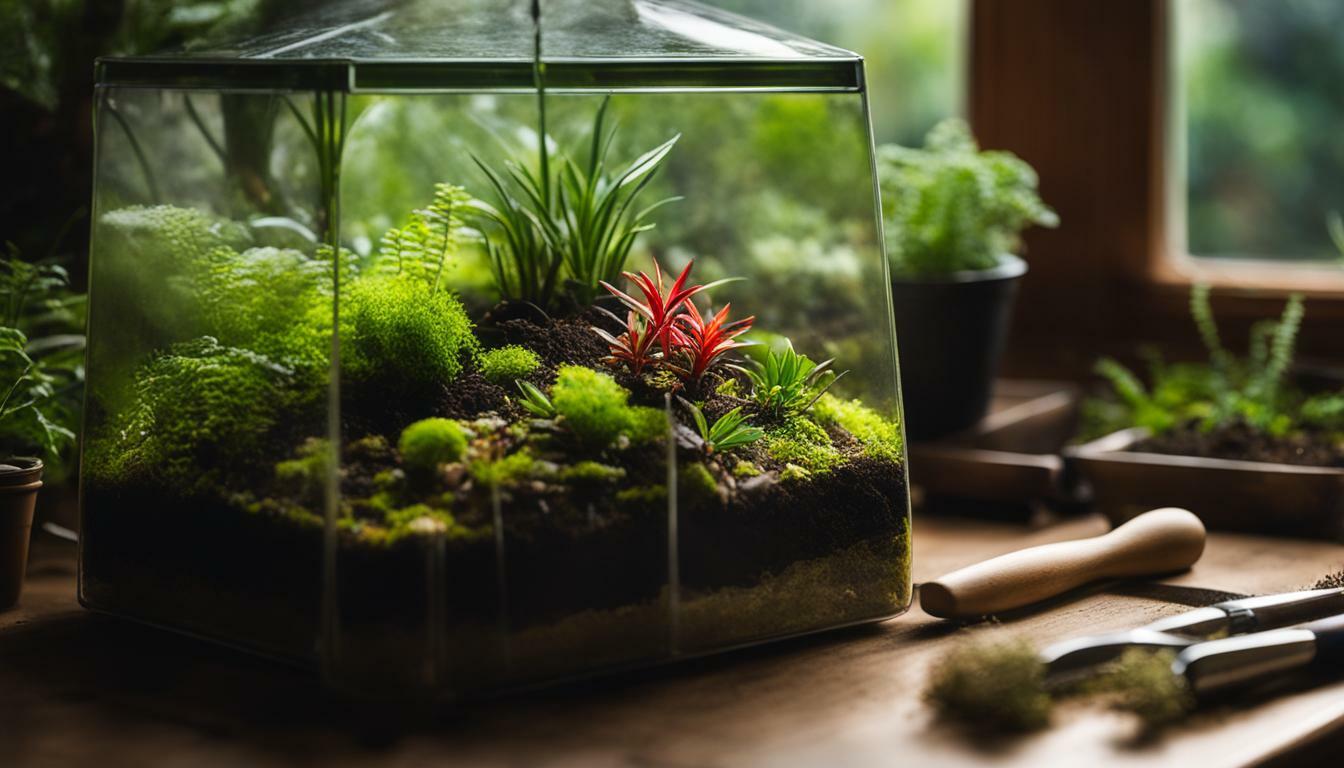When it comes to terrarium care, soil maintenance is key to ensuring the health and vitality of your enclosed plants. Proper soil maintenance is crucial for creating and maintaining a thriving ecosystem within your terrarium. With the right soil composition, moisture levels, drainage, pH balance, and nutrient supplementation, you can ensure the long-term health and vitality of your terrarium plants.
- Underwatering and overwatering are common mistakes in terrarium care.
- Pay attention to humidity levels and add water if condensation is lacking.
- Avoid excessive moisture by watering a little at a time.
- Provide bright indirect light for most tropical plants.
- Control mold growth by improving airflow and wiping with hydrogen peroxide or chamomile tea.
Mastering soil maintenance in your terrarium is essential for creating a beautiful and thriving ecosystem. By following these soil maintenance essentials, you can enjoy the beauty of your enclosed plants for years to come.
Terrarium Setup: Choosing the Right Soil
Before diving into terrarium care, it’s important to choose the right type of soil for your specific terrarium setup. The soil composition will greatly influence the success and growth of your terrarium plants. Here are some key factors to consider when selecting soil for your terrarium.
1. Drainage: Terrariums require well-draining soil to prevent waterlogging and root rot. Look for a soil mix that is specifically labeled for terrariums or one that is light and airy. Adding materials like perlite or sand can further improve drainage.
2. Moisture Retention: While proper drainage is essential, it’s also important for the soil to retain some moisture to keep the plants hydrated. Consider a soil mix that includes organic matter like peat moss or coir, which can help retain moisture without causing waterlogged conditions.
3. Nutrient Content: Terrarium plants rely on the soil for their nutrient needs. Look for a soil mix that is enriched with organic fertilizers or contains beneficial microorganisms like mycorrhizae. Alternatively, you can choose a neutral soil mix and supplement it with slow-release fertilizers or liquid fertilizers as needed.
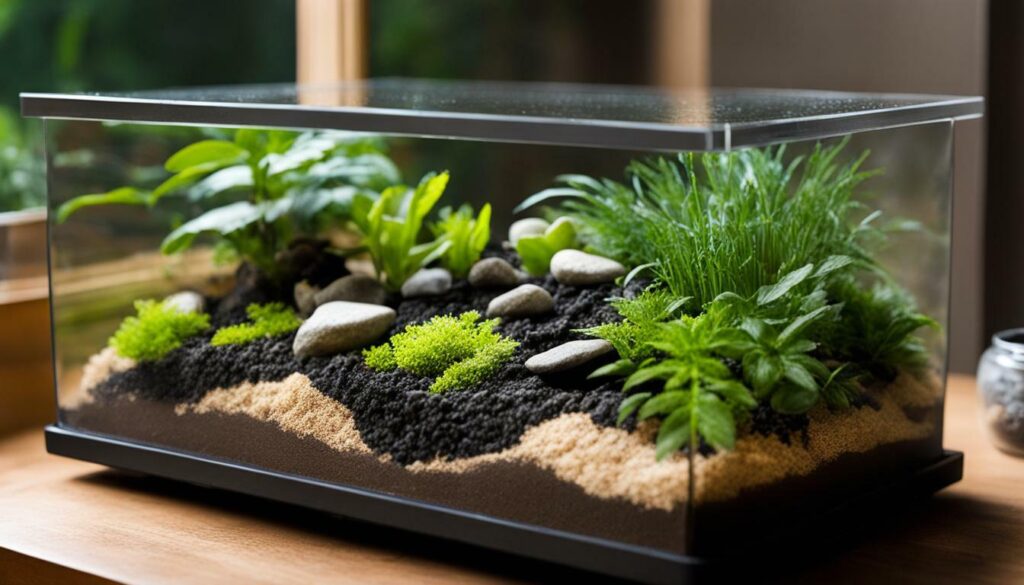
Remember, the soil composition can vary depending on the type of terrarium you have. For example, tropical terrariums may require a soil mix that is slightly acidic, while succulent terrariums may need a well-draining soil mix with a higher proportion of sand or perlite.
By choosing the right soil for your terrarium setup, you are setting the foundation for a healthy and thriving ecosystem. Take the time to research the specific needs of your terrarium plants and invest in quality soil that will provide them with the necessary nutrients and conditions for growth.
| Terrarium Type | Ideal Soil Composition | Plant Examples |
|---|---|---|
| Tropical Terrariums | Well-draining soil with organic matter | Ferns, Fittonias, Pothos |
| Succulent Terrariums | Sandy, well-draining soil mix | Succulents, Haworthias, Echeverias |
| Carnivorous Terrariums | Peat-rich soil with low mineral content | Pitcher Plants, Venus Flytraps, Sundews |
Understanding Terrarium Soil Types and Composition
To create a successful and thriving terrarium, it’s crucial to have a good understanding of the various types of soil and their compositions. Each type of soil has its own characteristics that can greatly impact the growth and overall health of your terrarium plants.
One common type of soil used in terrariums is potting soil. Potting soil is a mixture of organic materials such as peat moss, coconut coir, and compost, along with minerals like perlite or vermiculite. This type of soil is well-draining and provides essential nutrients for plant growth. It’s important to choose a high-quality potting soil that is specifically formulated for terrarium use.
Another type of soil commonly used is a mix of sand and sphagnum moss. This combination provides excellent drainage while retaining moisture, making it ideal for plants that require well-draining soil. The sand helps prevent compaction, while the sphagnum moss helps retain moisture and provides a loose texture for root growth.
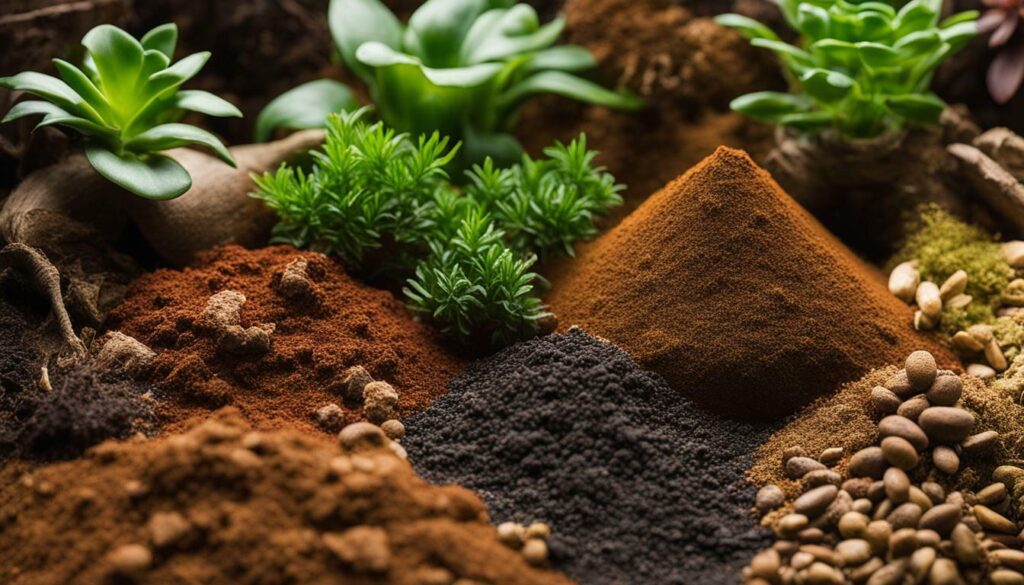
| Type of Soil | Composition | Characteristics |
|---|---|---|
| Potting Soil | Organic materials (peat moss, coconut coir, compost), minerals (perlite, vermiculite) | Well-draining, nutrient-rich |
| Sand and Sphagnum Moss Mix | Sand, sphagnum moss | Excellent drainage, moisture retention |
Other types of soil that can be used include cactus soil, which provides fast-draining properties suitable for succulents, and orchid bark, which is a blend of bark, charcoal, and perlite for epiphytic orchids that require good airflow and moisture control.
Understanding the composition of each soil type is essential as it allows you to select the most appropriate one for the specific needs of your plants. It’s important to consider the moisture retention, drainage, and nutrient content of the soil to ensure optimal growth and prevent issues such as root rot or nutrient deficiencies.
Maintaining Terrarium Soil Moisture Levels
Moisture levels play a vital role in the success of your terrarium, as the plants’ roots need a balance of water and air to thrive. Underwatering is a common mistake that can hinder plant growth and cause dehydration. To prevent this, regularly monitor the humidity levels inside your terrarium. If you notice a lack of condensation on the glass walls or a dry appearance of the soil, it’s a clear sign that your terrarium needs watering.
When watering your terrarium, it’s important to avoid overwatering, as excessive moisture can lead to root rot and the dreaded waterlogged soil. Instead, water your terrarium in small increments. Start by adding water to the terrarium’s base, allowing the plants to absorb the moisture through their roots. Wait for the soil to dry out slightly before watering again, ensuring that you maintain a careful balance between moist and dry soil.
In addition to watering, maintaining proper airflow can also help regulate moisture levels in your terrarium. Good ventilation allows excess moisture to evaporate, preventing the growth of mold or fungal diseases. If you notice any signs of mold growth, such as white fuzzy patches or a musty odor, improve airflow by slightly opening the terrarium’s lid or adding a small fan nearby.
To control mold growth and maintain a healthy terrarium environment, you can also wipe the glass walls with a solution of hydrogen peroxide. This helps remove any mold spores or buildup that may be present. Another natural approach is using chamomile tea, which has antifungal properties. Simply brew a weak chamomile tea, let it cool, and spray it onto the affected areas.
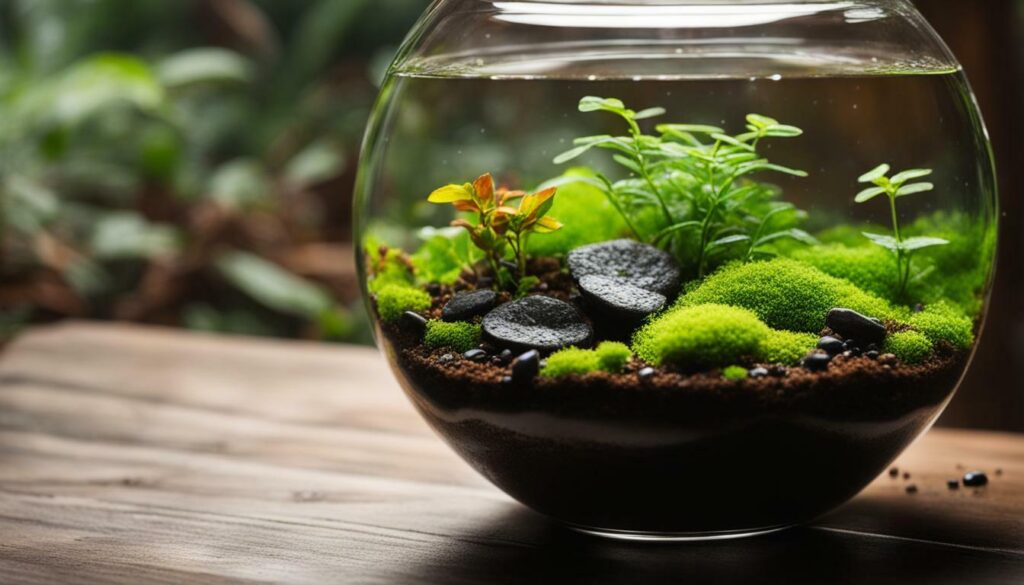
| Moisture Level | Recommended Actions |
|---|---|
| Too dry | Water your terrarium, ensuring the soil is evenly moist. Increase humidity by misting the plants. |
| Optimal | Maintain the current watering routine and monitor for any changes. |
| Too wet | Allow the soil to dry out slightly before watering again. Improve airflow to promote drying. |
“Proper moisture levels are essential for the health and longevity of your terrarium plants. Striking the right balance ensures that your plants receive adequate hydration without the risk of root rot or other moisture-related issues. Regular monitoring and adjustment of moisture levels will help create a thriving environment for your terrarium ecosystem.” – Terrarium Care Expert
Regular Maintenance Tips for Terrarium Soil
- Remove any decaying or rotting plant matter from the soil to prevent the spread of diseases and mold growth.
- Trim overgrown plants to maintain balance and prevent overcrowding, allowing better airflow and light penetration.
- Regularly clean the glass walls of your terrarium to ensure optimal visibility and light transmission for the plants.
- Monitor your terrarium’s moisture levels and adjust watering accordingly to maintain the ideal balance.
- Observe your plants for any signs of stress or nutrient deficiencies, as this can be an indication of soil-related issues.
Ensuring Terrarium Soil Drainage
Adequate drainage is crucial for preventing water buildup and ensuring the long-term health of your terrarium plants. When water accumulates in the soil, it can lead to root rot and other issues that can harm or even kill your plants. To promote proper drainage, there are a few steps you can take.
First, choose a well-draining soil mixture specifically designed for terrariums. These mixtures often contain ingredients like peat moss, perlite, or vermiculite, which help create air pockets and improve water flow within the soil. Avoid using regular potting soil, as it can retain too much moisture and hinder drainage.
Additionally, consider adding a layer of drainage material at the bottom of your terrarium. This can be small rocks, pebbles, or even activated charcoal. The layer should be about an inch thick and will help prevent water from pooling at the bottom, allowing excess moisture to escape.
| Benefits of Good Terrarium Soil Drainage |
|---|
| Prevents water buildup and root rot |
| Improves oxygen circulation to plant roots |
| Reduces the risk of fungal diseases |
| Helps maintain a healthy and balanced ecosystem |
Regularly monitor your terrarium’s moisture levels and adjust watering accordingly. It’s important to strike a balance between keeping the soil moist and allowing it to dry out slightly between waterings. Aim to water the terrarium sparingly, focusing on the base of the plants rather than saturating the entire soil surface.
By ensuring proper drainage in your terrarium, you can create a favorable environment for your plants to thrive. Regularly inspect the soil and make adjustments as needed to maintain optimal moisture levels. Your plants will thank you with their vibrant growth and beauty.
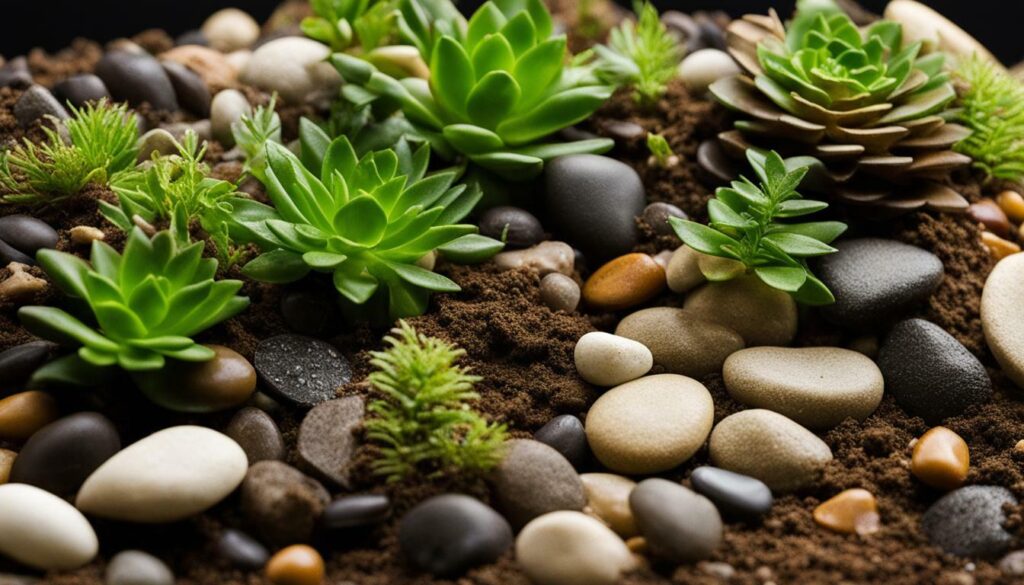
In order to provide the best growing conditions for your terrarium plants, it’s essential to understand the role of pH levels in the soil. pH is a measure of the acidity or alkalinity of the soil, and different plants have different pH preferences. The pH scale ranges from 0 to 14, with 7 being neutral. A pH below 7 indicates acidic soil, while a pH above 7 indicates alkaline soil. Most terrarium plants thrive in slightly acidic to neutral conditions, with a pH range of 6 to 7.5.
| pH Level | Soil Type |
|---|---|
| Below 6 | Acidic soil |
| 6 to 7.5 | Neutral to slightly acidic soil |
| Above 7.5 | Alkaline soil |
Measuring the pH of your terrarium soil is important to ensure that it is within the optimal range for your plants. You can use a pH testing kit or pH meter to accurately measure the pH level. If the pH is too high or too low, you can make adjustments by adding soil amendments. For example, if the soil is too acidic, you can add limestone or crushed eggshells to raise the pH. On the other hand, if the soil is too alkaline, you can add sulfur or coffee grounds to lower the pH.
It’s important to note that changes in pH should be done gradually to avoid shocking the plants. Regular monitoring of the pH levels and adjusting as necessary will help maintain a healthy and thriving terrarium ecosystem. By providing the proper pH conditions, you are ensuring that your plants can effectively absorb nutrients from the soil and thrive in their enclosed environment.
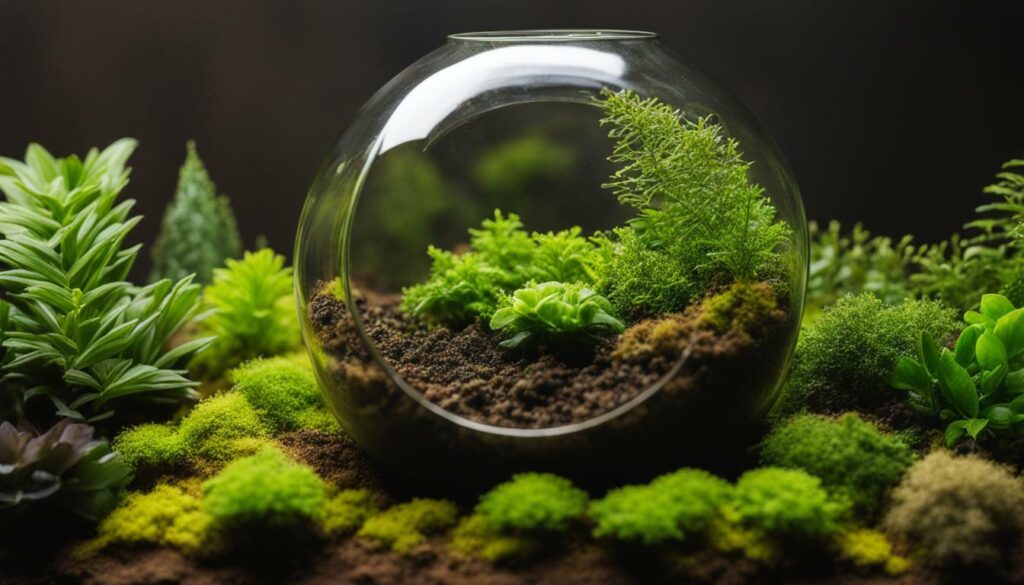
Terrarium Soil Amendment: Keeping the Soil Balanced
Regular soil amendments are necessary to maintain the optimal nutrient levels and overall health of your terrarium. Over time, the soil in your terrarium may become depleted of essential nutrients, posing a risk to the well-being of your plants. By incorporating soil amendments into your terrarium care routine, you can provide your plants with the necessary nutrients to thrive.
One effective soil amendment technique is the use of organic matter, such as compost or worm castings. These organic materials enrich the soil with vital nutrients and improve its structure, promoting healthy root growth and nutrient absorption. Simply mix a small amount of compost or worm castings into the top layer of the soil, ensuring it is evenly distributed throughout the terrarium.
In addition to organic matter, you can also utilize slow-release fertilizers to supplement the nutrient content of your terrarium soil. These fertilizers release nutrients gradually over time, providing a constant supply of essential elements for long-term plant growth. Be sure to follow the manufacturer’s instructions for application rates and frequency to prevent over-fertilization.
It is important to monitor the nutrient levels in your terrarium soil periodically. Conducting soil tests can help you identify any deficiencies or imbalances and adjust your soil amendment practices accordingly. Additionally, observe your plants for signs of nutrient deficiencies, such as yellowing leaves or stunted growth, and address any issues promptly with appropriate amendments.
| Nutrient | Function | Plant Sources |
|---|---|---|
| Nitrogen (N) | Essential for growth and leaf development | Compost, blood meal, fish emulsion |
| Phosphorus (P) | Promotes root development and flowering | Bone meal, rock phosphate |
| Potassium (K) | Aids in overall plant health and stress resistance | Kelp meal, wood ash, banana peels |
| Calcium (Ca) | Strengthens cell walls and promotes nutrient uptake | Gypsum, eggshells |
| Magnesium (Mg) | Essential for photosynthesis and chlorophyll production | Epsom salt, dolomite lime |
Remember to find the balance when amending your terrarium soil. Avoid over-amending, as excessive nutrient levels can be detrimental to your plants. Follow the recommended application rates and monitor your terrarium’s overall health to ensure the amendments are benefiting your plants.
“Soil amendments provide a nutritional boost to your terrarium plants, helping them thrive in their enclosed environment.” – Terrarium Care Expert
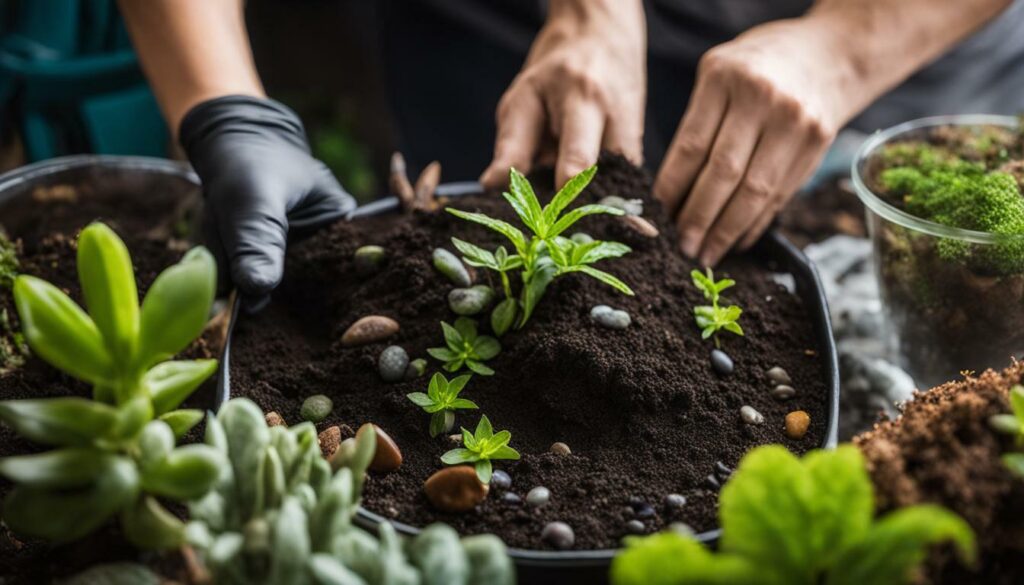
By regularly amending your terrarium soil and providing the necessary nutrients, you can create a balanced and fertile environment for your plants to flourish. Remember to tailor your soil amendment practices to the specific needs of your terrarium plants and adjust as necessary. With proper soil maintenance, your terrarium can become a thriving ecosystem, bringing beauty and greenery into your space.
Troubleshooting Terrarium Soil Issues
Despite your best efforts, terrarium soil issues can arise, but with the right knowledge and troubleshooting techniques, they can be resolved. Here are some common soil problems you may encounter in your terrarium and how to address them:
1. Underwatering
One common mistake in terrarium care is underwatering the soil. To identify if your terrarium needs water, check the humidity levels and look for condensation on the glass walls. If condensation is lacking, it’s a sign that your terrarium needs watering. Add water sparingly to avoid overwatering.
2. Overwatering
Overwatering is a greater risk for terrariums and can lead to saturation of the soil, causing root rot and fungal growth. To prevent overwatering, water your terrarium sparingly and in small amounts. Ensure proper drainage in the terrarium to avoid waterlogging. It’s best to use a spray bottle or a watering can with a narrow spout for precise watering.
3. Insufficient Light
Light is essential for the growth and well-being of plants in a terrarium. Lack of light can cause weak or stunted growth. Ensure your terrarium is placed in an area with bright indirect light, as direct sunlight can scorch the plants. Supplementing with artificial grow lights may be necessary if natural light is limited.
4. Mold Growth
Mold is a common issue in terrariums due to the high humidity levels. To control mold growth, ensure proper airflow within the terrarium by slightly opening the lid or introducing a small fan. Wipe off any visible mold with a cloth soaked in hydrogen peroxide or use a diluted solution of chamomile tea as a natural mold inhibitor.
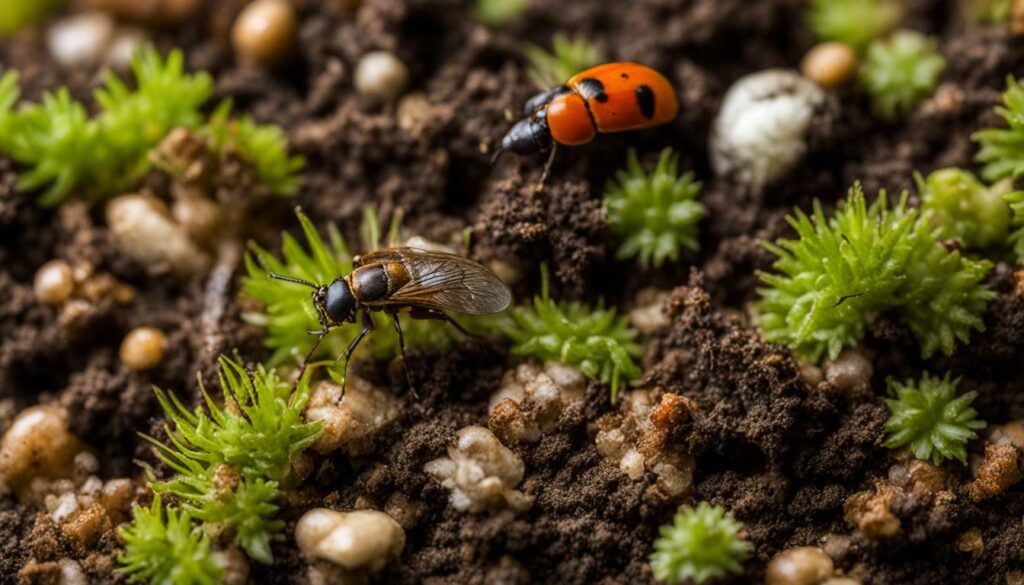
Remember to remove any rotting plants or trim overgrown plants regularly to maintain a healthy balance and prevent mold growth. Cleaning the terrarium glass with a soft cloth or sponge is also necessary to ensure optimal plant health and to allow maximum light penetration.
By addressing these common terrarium soil issues promptly and following proper maintenance practices, you can ensure the long-term health and success of your terrarium plants.
What Are the Essential Soil Maintenance Tips for Terrarium Care?
When it comes to terrarium soil selection and care, there are a few essential tips to keep in mind. First, choose a well-draining potting mix to prevent waterlogged roots. Additionally, consider adding activated charcoal to the soil to help maintain freshness and prevent odors. Finally, monitor moisture levels and water sparingly to avoid rotting roots.
Conclusion
By following the essential soil maintenance steps outlined in this guide, you can create and maintain a stunning terrarium that will bring joy and beauty to your home or office space.
Mastering terrarium care requires attention to soil maintenance essentials. One common mistake is underwatering the terrarium, which can be identified by checking the humidity and adding water if condensation is lacking. Overwatering is a greater risk and can lead to saturation of the substrate, so it’s best to water a little at a time and avoid excessive moisture.
Finding the right amount of light is crucial, with bright indirect light being ideal for most tropical plants. It’s important to place your terrarium in a location that receives the right balance of sunlight. Too much direct sunlight can cause overheating and damage to the plants, while too little light can result in weak growth.
Mold is a common issue in terrariums, but it can be controlled by improving airflow, wiping with hydrogen peroxide, or using chamomile tea. Removing rotting plants and trimming overgrown plants is important to maintain balance and prevent mold growth. Regularly cleaning the terrarium glass is also necessary to ensure optimal plant health.
By following these tips and guidelines for soil maintenance, your terrarium will thrive and provide a beautiful, green oasis in your living or working space. Remember to pay attention to the moisture levels, drainage, pH balance, and nutrient supplementation to ensure the long-term health and vitality of your terrarium plants. Enjoy the rewards of your effort and watch as your terrarium transforms into a miniature world of natural beauty.
FAQ
What is the most common mistake when it comes to terrarium care and soil maintenance?
The most common mistake is underwatering the terrarium. It’s important to check the humidity and add water if condensation is lacking.
How can I prevent overwatering my terrarium?
To avoid overwatering, it’s best to water a little at a time and avoid excessive moisture. Ensure that the substrate doesn’t become saturated.
What kind of light should I provide for my terrarium plants?
Bright indirect light is ideal for most tropical plants in a terrarium.
How can I prevent mold growth in my terrarium?
To control mold, you can improve airflow, wipe the terrarium with hydrogen peroxide, or use chamomile tea.
Why is removing rotting plants and trimming overgrown plants important in a terrarium?
Removing rotting plants and trimming overgrown plants helps maintain balance and prevent mold growth.
How often should I clean the glass of my terrarium?
It’s necessary to clean the terrarium glass regularly to ensure optimal plant health.

